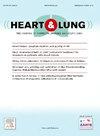早期使用血管紧张素受体Neprilysin抑制剂(ARNi)和钠-葡萄糖共转运蛋白2抑制剂(SGLT2i)对新发和慢性HFrEF的影响
IF 2.6
4区 医学
Q2 CARDIAC & CARDIOVASCULAR SYSTEMS
引用次数: 0
摘要
背景:尽管有强有力的证据表明,GDMT治疗HFrEF的随机临床试验可以改善死亡率和预后,并减少与hf相关的住院治疗,但我们仍然经历了GDMT的次优使用。HFrEF的四大支柱的有益医疗效果不容忽视。已经实施了大量的工作,例如指导方针和质量改进(QI)计划,以减轻差距,但结果仍然不令人满意。积极启动GDMT应该是高度优先考虑的。目的:分析早期启动GDMT并强化使用ARNi和SGLT2对新发和慢性HFrEF合并缺血性和非缺血性心肌病患者的影响。从2020年到2023年,284例HFrEF患者被纳入GDMT优化项目,作为由HF NP和药剂师领导的QI倡议。方法/过程对患者进行随访,直至达到三联或四联治疗的目标剂量或最大耐受剂量。收集的数据包括超声心动图、实验室值、NYHA和hf相关的再入院率。随访3至6个月完成超声心动图,并在项目完成后6个月评估hf相关再入院情况。在参与者中,94.9%在心衰诊所评估后3个月内入组。平均年龄为64岁;70%为男性。新发HF患者较多(55%),多数为非缺血性(62.3%)。完成治疗后,两组接受三联和四联治疗的患者均有相似的增加。在评估结束时,两组的ARNi使用率(79.2%对84.9%)和sgltti使用率(64.8%对65.6%)较高。新发组LVEF改善的比例较高,其绝对改善程度也较大。在治疗过程中,两组的NYHA评分均有所提高。观察到BNP减少,新发患者的hf相关再入院率(7.5%)明显低于慢性组(19.2%)。实际意义强化使用ARNi和SGLT2i的结果强调了诊断HFrEF后立即开始治疗的紧迫性。无论病因如何,与慢性HFrEF相比,新诊断的HFrEF早期开始GDMT可以更大程度地改善LVEF,减少BNP和hf相关的再入院。本文章由计算机程序翻译,如有差异,请以英文原文为准。
The Impact Of Increased Early Utilization Of Angiotensin Receptor Neprilysin Inhibitor (ARNi) And Sodium-Glucose Cotransporter 2 Inhibitors (SGLT2i) In New Onset And Chronic HFrEF
Background
Despite strong evidence of randomized clinical trials on GDMT for HFrEF in improving mortality and outcomes and reducing HF-related hospitalization, we continue to experience suboptimal use of GDMT. The beneficial medical effects of the 4 pillars of HFrEF cannot be ignored. Considerable efforts, such as guidelines and quality improvement (QI) initiatives, are implemented to mitigate the gaps, and results remain unsatisfactory. Aggressive initiation of GDMT should be a high priority.
Purpose
We analyzed the impact of early GDMT initiation with intensified use of ARNi and SGLT2 in new-onset and chronic HFrEF patients with ischemic and nonischemic cardiomyopathy.
Setting/Population
From 2020 to 2023, 284 patients with HFrEF were enrolled in the GDMT optimization program as a QI initiative led by HF NP and pharmacist.
Method/Process
Patients were followed until they achieved the target or maximum tolerated dose of triple or quadruple therapy. Data collected included echocardiography, laboratory values, NYHA, and HF-related hospital readmissions. Follow-up echocardiography was completed between 3 and 6 months, and HF-related readmission was assessed up to 6 months after completion of the program.
Outcome Measures
Among the participants, 94.9% were enrolled within 3 months after being evaluated in the HF clinic. The average age was 64; 70% were male. There were more patients with new onset HF (55%), and the majority were nonischemic (62.3%). Upon completion, there was a similar increase in both groups of those who were on triple and quadruple therapy. The use of ARNi (79.2% vs 84.9%) and SGLT2i (64.8% vs 65.6%) was higher in the two groups at the end of evaluation. A higher percentage of the new onset group had improvement of LVEF, and their absolute degree of improvement was also greater. NYHA Class improved in both groups over the course of therapy. A reduction of BNP was observed, and HF-related readmissions were significantly lower in the new-onset (7.5%) vs the chronic group (19.2%).
Practical Implications
The outcome of intensified use of ARNi and SGLT2i underscores the urgency of initiating treatment immediately after diagnosis of HFrEF. Despite etiology, early initiation of GDMT in newly diagnosed HFrEF demonstrates a greater improvement of LVEF, reduction in BNP, and HF-related readmission compared to chronic HFrEF.
求助全文
通过发布文献求助,成功后即可免费获取论文全文。
去求助
来源期刊

Heart & Lung
医学-呼吸系统
CiteScore
4.60
自引率
3.60%
发文量
184
审稿时长
35 days
期刊介绍:
Heart & Lung: The Journal of Cardiopulmonary and Acute Care, the official publication of The American Association of Heart Failure Nurses, presents original, peer-reviewed articles on techniques, advances, investigations, and observations related to the care of patients with acute and critical illness and patients with chronic cardiac or pulmonary disorders.
The Journal''s acute care articles focus on the care of hospitalized patients, including those in the critical and acute care settings. Because most patients who are hospitalized in acute and critical care settings have chronic conditions, we are also interested in the chronically critically ill, the care of patients with chronic cardiopulmonary disorders, their rehabilitation, and disease prevention. The Journal''s heart failure articles focus on all aspects of the care of patients with this condition. Manuscripts that are relevant to populations across the human lifespan are welcome.
 求助内容:
求助内容: 应助结果提醒方式:
应助结果提醒方式:


